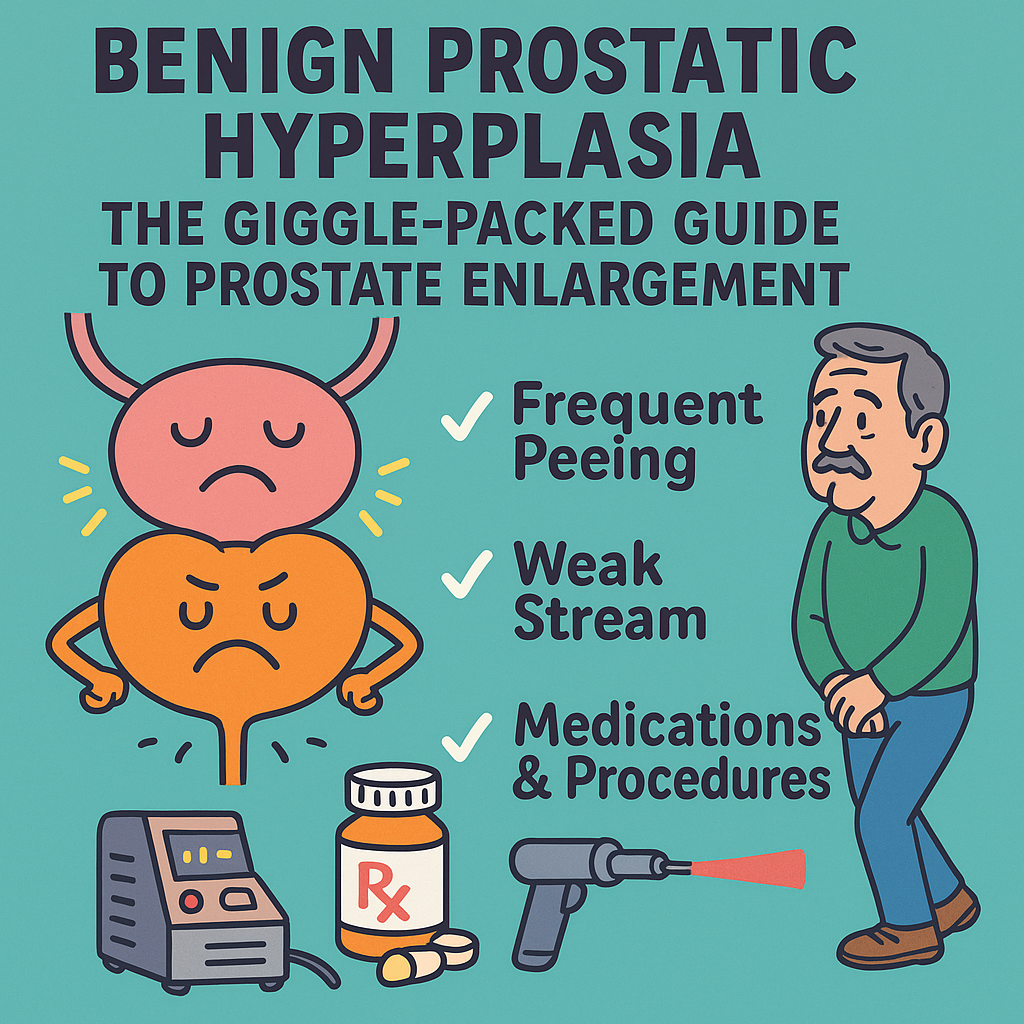
What Is Benign Prostatic Hyperplasia? (aka BPH )
So here we are—talking about benign prostatic hyperplasia. Don’t gasp! Yes, it’s long, but let’s unpack it: “benign” means not cancerous, “prostatic” means prostate gland, and “hyperplasia” means the gland has a growth spurt. In regular English? It’s when your prostate decides to throw itself a midlife-party and grows too big, squeezing your urinary plumbing in the process.
The Prostate: Your Tiny, Yearning Gland
The prostate is a walnut-sized gland that hangs out under the bladder and contributes to reproductive magic. Normally low‑key and chill—then bam! it starts hogging space.
“Benign” vs. “Prostatic” vs. “Hyperplasia”—What’s the Deal?
- Benign: No cancer here, folks!
- Prostatic: It’s all about that prostate.
- Hyperplasia: Fancy word for overgrowth.
Put it all together and you’ve got BPH—a not-so-slow-growing enlargement that can make life… interesting.
Causes of BPH: Why the Prostate Gets Moody
Hormones Gone Wild (Hello, Dihydrotestosterone!)
As men age, testosterone can convert to dihydrotestosterone (DHT), which signals the prostate to grow. Think of DHT as the frat-house party planner your prostate never asked for.
Aging: Not Just a Fashion Statement
BPH lurks in about 50% of men by age 60 and up to 90% by age 85. Your prostate gets more attention than your hairline at that point!
Family History: Thanks, Grandpa
If pops or grandpa had BPH, guess who’s likely to join the club? Genetics doesn’t lie.
Signs & Symptoms of BPH
Frequent Peeing
You start sprinting to the bathroom like it’s a toilet Olympics. That’s your bladder begging—no, demanding—relief.
Weak Stream & Dribble
What used to be a waterfall turns into a sad trickle and maybe a dribble encore. Nobody wants curtain call on their pants.
Straining Situations & Overflow Incontinence
Need to push? Strain like you’re lifting weights? Then maybe leak a bit when you’re full. Delightful stuff.
Diagnosis of BPH
Digital Rectal Exam (DRE): Yes, Really
Doctor slides a gloved finger—gently—up there to check size. A bit awkward, but quick. You’ll get through it!
PSA Tests: Prostate‑Specific … What?
PSA is a blood marker that can go up in BPH. It’s not just about cancer, but your doc wants to check anyway. Not confirmatory, as it increases in many other diseases of the prostate.
Treatment Options for BPH
Watchful Waiting: Prostate Meditation
Symptom mild? Sit back, sip water, and monitor progress. Zen prostate mode.
Medications: Alpha‑Blockers, 5‑Alpha‑Reductase Inhibitors
- Alpha‑Blockers (like tamsulosin) relax bladder muscles—pee easier.
- 5‑ARI (like finasteride) shrink the gland—bye bye overgrowth.
Minimally Invasive Procedures: GreenLight Laser Fun
Laser vaporizes prostate bits. Fancy tech, minimal downtime. Outpatient grooviness.
Surgical Options: TURP
Transurethral resection (TURP) shaves prostate bits via the urethra—no external incision. Some call it the gold standard.
Home Remedies & Lifestyle Hacks (No Prescription Needed)
Diet Tweaks: Pumpkin Seeds & Cranberries, Oh My!
Anti‑inflammatory foods, like pumpkin seeds, can soothe your urinary system. Cranberry juice = bladder superstar.
Exercise: Pelvic Floor Workouts
Kegel exercises aren’t just for moms—men benefit too! Strengthen those pelvic muscles to combat leakage.
Hydration & Bathroom Strategy
Drink fluids early in the day, hold back at night. Avoid caffeine and alcohol—they’re sneaky diuretics.
Frequently Asked Questions (FAQs)
1. What is benign prostatic hyperplasia?
BPH is a non‑cancerous enlargement of the prostate that can obstruct urine flow as men age.
2. Is BPH cancer?
Nope! BPH is entirely benign. However, its symptoms overlap with prostate disease, so check with your doc.
3. Can BPH cause urinary tract infections?
Yes—urine retention from BPH can raise your risk of UTIs if bacteria hang around too long.
4. Best treatment for enlarged prostate?
Depends on severity: start with lifestyle tweaks, then meds, minimally invasive options, and surgery if needed.
5. How common is enlarged prostate?
About 50% of men aged 60 and nearly 90% over 85 have some prostate enlargement.
6. Lifestyle changes for prostate health?
Eat anti‑inflammatory foods, maintain healthy weight, exercise pelvic muscles, and manage fluid intake.
Conclusion: Taming the Prostate with a Smile
Benign prostatic hyperplasia isn’t a walk in the park—but with humor, helpful tips, and modern medicine, you can conquer the bathroom ballet. Chat with your doctor, stay informed, laugh at the absurdity, and keep that prostate in check!
For more info on prostate problems, check out National Institute on Aging – Prostate Problems
